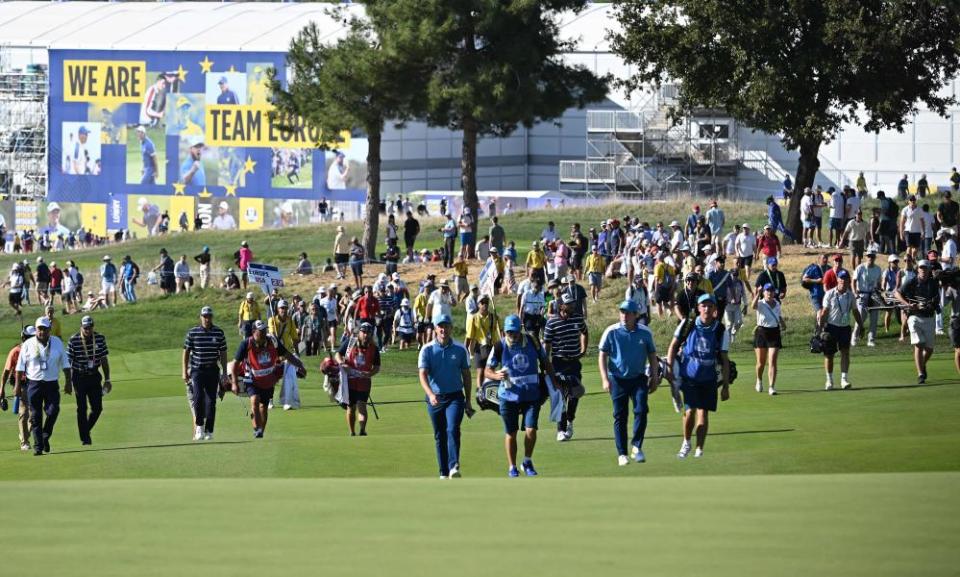Come with me, behind the ropes for a front-row seat in sport’s theatre of history

You get a fluorescent green bib from the front desk, and it makes you look a bit like you’re about to do community service, but you don’t really mind, because what you’ve just been given is actually a golden key. One of the most precious items in the whole of sportswriting – right up there with your thesaurus, your dog-eared envelope full of expense receipts, and Wikipedia. You’re about to enter a magical portal into a sunlit universe of big swings and perfumed shoulders, cigar smoke and mild swearing.
There are times in this job when you feel the need to explain to people that actually, it’s not as opulent and idyllic as it all seems. That there are deadlines and demands, brutally early starts and late nights, interminable hours spent in windowless rooms waiting for a man in a tracksuit to shower you in banalities, long train journeys with Jonathan Wilson. Then, of course, there are the moments that just need to be savoured and shared. Lean into the smugness. Come with me. We’re going behind the ropes at the Ryder Cup.
Related: Postcards from Rome: Guardian writers give their Ryder Cup verdicts
Is there any other sport that grants this kind of intimacy at its very highest level? The equivalent would probably be watching a Champions League final from the dugout, or crouching behind the starting blocks as the silence falls at the Olympic 100m final. Most sports fiercely guard their sacred turf, draw a steel ring around it, buffer it with stern signs and security detail, keep you at a safe distance. But here we are at the 2nd tee of the Marco Simone Golf & Country Club, so close to Justin Thomas that you could reach out and grab the yardage book from his back pocket. It’s madness. It almost certainly won’t last. But right now, it’s about as close as it is possible to get to the heart of elite sport.
Jordan Spieth lines up his tee shot. Has a little discussion with his caddie about whether he can carry the bunkers on the left. Steps up to address. You hear the swish of his three wood as it snaps through the hot air and the violent metallic explosion as the ball takes flight. You see exactly what he sees: the ball disappearing into a cloudless sky, over the galleries and the scoreboards, the sweet stall and the portable toilets, finally landing in the thick grass, bobbing up twice before disappearing into the undergrowth. The crowd emits a low, menacing chuckle. Spieth’s brow, already wet with sweat, furrows a little. Then he hands the club back to his caddie and shoves his hands in his pockets.
We set off down the side of the fairway, tramping through the wild grass and over steep banks. And at the modern Ryder Cup there is quite the travelling circus: wives and partners, vice-captains and VIPs, marshals and carabinieri, scorers and spotters and snappers and scribes. You catch little fragments of conversation. One of the players’ mothers says she’s thinking of going horse riding on Monday. One of the wives admits that she doesn’t really understand the difference between strokeplay and matchplay. There are frequent complaints from the Americans about the boorishness and entitlement of the crowds.

The feeling is undoubtedly mutual. Imagine: you’ve paid thousands of pounds for Ryder Cup tickets and travel, set the alarm for 4am, queued for a rattling shuttle bus, spent most of the day on tiptoe staring at other people’s necks and, just as you finally stake out a prime location by the 14th green, some VIP freeloaders plonk themselves right in your eyeline. “Sorry,” you mew pathetically, and in a way you’re not just apologising for blocking their view but for venturing beyond the rope in the first place, for being the kind of person who wears the bib, for the temerity of privilege.
But you don’t really mind this either, because occasionally you also get a front-row seat in the theatre of history. Back in 2012, through a confluence of extremely fortuitous circumstances, I found myself perching by the 17th green as Martin Kaymer stood over a putt to beat Steve Stricker. All of a sudden I heard a strange sound: someone grabbing fistfuls of grass. It was Stricker’s daughter Bobbi, maybe 12 years old, pained and anxious, digging her fingernails into the turf a few yards away. “Please miss, please miss, please miss,” she begged under her breath. Well, Kaymer did not miss. Europe won the Ryder Cup. Bobbi started to cry. And that’s how I experienced the miracle of Medinah.
It felt special back then, and if anything feels even more so now. Perhaps this is because these days live sport is essentially packaged as something you can glimpse but never touch. Watch footage of old World Cups or Test matches or even Formula One grand prix, and the crowd is right there, on the very edge of the field of play, not separate from the spectacle but bleeding into it.
And this was always the point, right? This is why we started going to sporting events in the first place: to feel the glow of the divine, to prickle the senses in a way television can only approximate.
Now, beyond golf and road cycling, this is a world that has largely disappeared, replaced by security cordons and press officers and varying degrees of choreographed cheerleading. Come. We need to head back and return the bib to the front desk. But for a couple of hours, we got to live in the dream while it was being made.

